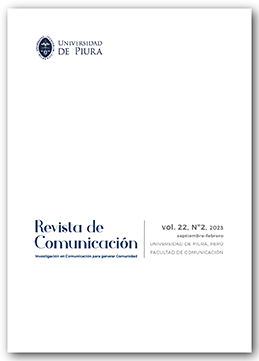Estudio exploratorio sobre qué significa ‘engagement’ en las empresas de comunicación
DOI:
https://doi.org/10.26441/RC22.2-2023-3159Palabras clave:
audience engagement, medios digitales, métricas de engagement, producción de contenidosResumen
En los últimos tiempos, la investigación y la industria han puesto un énfasis especial en el concepto de engagement y la literatura académica al respecto es extensa. A pesar de que la lealtad y el compromiso son la piedra angular de los medios de comunicación, no todas las empresas han desarrollado estrategias para involucrar aún más a la audiencia en los contenidos. Para las compañías de medios contar con la participación de la audiencia plantea un doble dilema. El reto de garantizar su propuesta de valor basada en sus principios configuradores o acoger pareceres y criterios de personas ajenas a las compañías y sin cualificación. Por tanto, hace falta una reflexión para analizar en qué medida estrategias encaminadas a aumentar el engagement contribuyen a extender el valor de la marca de las empresas de comunicación. Con este dilema y tras un repaso de la literatura más reciente, elaboramos un cuestionario para conocer cómo definían y cómo medían el engagement profesionales y gestores de compañías de comunicación de sectores diferentes. Tras el estudio realizado, concluimos que para las compañías cuyo core business está vinculado al entorno digital, la cercanía con las audiencias es mayor que los medios tradicionales o aquellas compañías como las productoras audiovisuales, cuyo negocio se dirige a otras empresas en lugar del público final.
Métricas
Citas
Andrejevic, M. (2008). Watching Television Without Pity. The Productivity of Online Fans. Television & New Media, 9(1),24–46. https://doi.org/10.1177/1527476407307241 DOI: https://doi.org/10.1177/1527476407307241
Arrese, A. (2004). Some considerations on the management of media products and contents. Communication and Society, 17 (2), 9-44. https://revistas.unav.edu/index.php/communication-and-society/article/view/36331 DOI: https://doi.org/10.15581/003.17.36331
Askwith, I. (2007, August 10). Television 2.0: Reconceptualizing TV as an Engagement Medium. MIT Graduate Program in Comparative Media Studies. https://cms.mit.edu/television-2-0-tv-as-an-engagement-medium/.
Atarama-Rojas, T., Guerrero-Pérez, E. & Gerbolini, V. (2020). Participation and Transmediality: Audience Influence on Web Series. International Journal of Communication, 14, 3614–3632. https://ijoc.org/index.php/ijoc/article/view/14024/3144
Bonini, T. & Sellas, T. (2014). Twitter as a public service medium? A content analysis of the Twitter use made by Radio RAI and RNE. Communication & Society, 27(2), 125-146. https://doi.org/10.15581/003.27.2.125-146 DOI: https://doi.org/10.15581/003.27.35998
Boyd, D. & Crawford, K. (2012). Critical Questions For Big Data. Information, Communication & Society, 15(5), 662-679. https://doi.org.10.1080/1369118X.2012.678878 DOI: https://doi.org/10.1080/1369118X.2012.678878
Broersma M (2019) Audience engagement. In T.P. Vos, F. Hanusch & D. Dimitrakopoulou. (Eds.). The International Encyclopedia of Journalism Studies (pp. 1-6). Wiley. https://doi.org/10.1002/9781118841570.iejs0060 DOI: https://doi.org/10.1002/9781118841570.iejs0060
Carlsson, E. & Nilsson, B. (2016). Technologies of participation: Community news and social media in Northern Sweden. Journalism,17(8),1113-1128. https://doi.org/10.1177/1464884915599948 DOI: https://doi.org/10.1177/1464884915599948
Carpentier, N. (2011). Media and Participation-A site of ideological democratic struggle. Intellect. DOI: https://doi.org/10.26530/OAPEN_606390
Chan-Olmsted, S. & Shay, R. (2015). Media branding 3.0: From media brands to branded entertainment and information. In G. Siegert, K. Förster, S. Chan-Olmsted & M. Ots (Eds.) Handbook of media branding (pp. 11–32). Springer. DOI: https://doi.org/10.1007/978-3-319-18236-0_2
Chan-Olmsted, S. & Wolter, L.C. (2018). Perceptions and practices of media engagement: A global perspective. International Journal on Media Management, 20(1), 1-24. https://doi.org/10.1080/14241277.2017.1402183 DOI: https://doi.org/10.1080/14241277.2017.1402183
Domingo, D., Thorsten, Q., Ari, H., Paulussen, S., Singer, J. & Vujnovic, M. (2008) Participatory journalism practices in the media beyond. Journalism Practice, 2(3), 326-342. https://doi.org/10.1080/17512780802281065 DOI: https://doi.org/10.1080/17512780802281065
Edlom, J. (2022) The Engagement Imperative: Experiences of Communication Practitioners’ Brand Work in the Music Industry. Media and Communication, 10(1), 66-76. https://doi.org/10.17645/mac.v10i1.4448 DOI: https://doi.org/10.17645/mac.v10i1.4448
Engelke, K. (2020). Enriching the Conversation: Audience Perspectives on the Deliberative Nature and Potential of User Comments for News Media. Digital Journalism,8(4), 447-466. https://doi.org/10.1080/21670811.2019.1680567 DOI: https://doi.org/10.1080/21670811.2019.1680567
Evans, E. (2019). Understanding Engagement in Transmedia Culture. Routledge. https://doi.org/10.4324/9781315208053 DOI: https://doi.org/10.4324/9781315208053
Fuente, C. (2007). Los principios editoriales, exigencia ética de las empresas informativas. Miscelánea Comillas Revista de Ciencias Humanas y Sociales 65 (126), 449-465. https://revistas.comillas.edu/index.php/miscelaneacomillas/article/view/7319
Gajardo, C. & Costera, I. (2022) How to tackle the conceptual inconsistency of audience engagement? The introduction of the Dynamic Model of Audience Engagement. Journalism, 0(0), 1-21. https://doi.org:10.1177/14648849221080356 DOI: https://doi.org/10.1177/14648849221080356
García-Avilés, J.A. (2012). Roles of audience participation in multiplatform television: From fans and consumers to collaborators and activists, Participations. Journal of Audience and Reception Studies, 9(2),429-447. http://dspace.umh.es/handle/11000/4574
Gordon, B. R., Zettelmeyer, F., Bhargava, N., & Chapsky, D. (2019). A comparison of approaches to advertising measurement: Evidence from big field experiments at Facebook. Marketing Science, 38(2), 193-225. https://doi.org/10.1287/mksc.2018.1135 DOI: https://doi.org/10.1287/mksc.2018.1135
Grueskin, B., Seave, A. & Graves. L. (2011, May, 10). The Story So Far: What We Know About the Business of Digital Journalism. Columbia Journalism Review. https://archives.cjr.org/the_business_of_digital_journalism/the_story_so_far_what_we_know.php
Guerrero, E., Diego, P & Kimber, D. (2017). Hooked on lit screen. El profesional de la información, 2 (6), 1108-117. https://doi.org/10.3145/epi.2017.nov.10 DOI: https://doi.org/10.3145/epi.2017.nov.10
Guo, M. & Chan-Olmsted, M. (2015). Predictors of social television viewing: How perceived program, media, and audience characteristics affect social engagement with television programming. Journal of Broadcasting & Electronic Media, 59(2), 240–258. https://doi.org/10.1080/08838151.2015.1029122 DOI: https://doi.org/10.1080/08838151.2015.1029122
Guo, M. (2018). How Television Viewers Use Social Media to Engage with Programming: The Social Engagement Scale Development and Validation. Journal of Broadcasting and Electronic Media, 62(2), 195-214. https://doi.org/10.1080/08838151.2018.1451856 DOI: https://doi.org/10.1080/08838151.2018.1451856
Hill, S. (2014). TV Audience Measurement with Big Data. Big Data, 2(2), 76-86. https://doi.org/10.1089/big.2014.0012 DOI: https://doi.org/10.1089/big.2014.0012
Huertas, A., Setó-Pàmies, D.& Míguez-González, M.I. (2015). Comunicación de destinos turísticos a través de los medios sociales. El profesional de la información, 24(1), 15-21. https://doi.org/10.3145/epi.2015.ene.02 DOI: https://doi.org/10.3145/epi.2015.ene.02
IAB (2016). Observatorio de marcas en redes sociales. IAB. https://iabspain.es/wp-content/uploads/2017/04/observatorio-marcas-rrss_2016_vfinal_reducida.pdf
Iglesias, F. & Blanco, M. (2007). Principios editoriales y principios configuradores en el pensamiento del profesor Alfonso Nieto Tamargo. Doxa Comunicación 2, 9-24. https://doi.org/10.31921/doxacom.n2 DOI: https://doi.org/10.31921/doxacom.n2a1
Jenkins, H., Ford, S. & Green, J. (2013). Spreadable Media: Creating Value and Meaning in a Networked Culture. New York: New York University Press.
Kleer, N. & Kunz, R. H. (2021). The Impact of Actor Engagement on the Business Models of Video Game Developers. International Journal on Media Management, 23 (3-4), 204-237. https://doi.org/10.1080/14241277.2022.2038604 DOI: https://doi.org/10.1080/14241277.2022.2038604
Kujur, F. & Singh, S. (2017). Engaging customers through online participation in social networking sites. Asia Pacific Management Review, 22 (1), 16-24. https://doi.org/10.1016/j.apmrv.2016.10.006 DOI: https://doi.org/10.1016/j.apmrv.2016.10.006
Kumar, V. & Pansari, A. (2016). Competitive advantage through engagement. Journal of Marketing Research, 53(4), 497-514. https://doi.org/10.1509/jmr.15.0044 DOI: https://doi.org/10.1509/jmr.15.0044
Łódzki, B. (2022). News shareability analysis: Global television channels as sources of information during the pandemic. In K. Kopecka-Piech & B. Łódzki. The Covid-19 Pandemic as a Challenge for Media and Communication Studies (pp. 93-104). Routledge. https://doi.org/10.4324/9781003232049-10 DOI: https://doi.org/10.4324/9781003232049-10
Macnamara, J. (2019). Explicating Listening in Organization–Public Communication: Theory, Practices, Technologies. International Journal of Communication 13, 5183–5204. https://ijoc.org/index.php/ijoc/article/view/11996/2839
Malhotra, N. K. (2019). Marketing Research: An Applied Orientation. Pearson Education.
Manovich, L. (2018). 100 Billion Data Rows per Second: Media Analytics in the Early 21st Century. International Journal of Communication 12, 473–488. http://manovich.net/content/04-projects/095-media-analytics/100_billion_data_rows.pdf
Medina, M., Sánchez-Tabernero, A., & Breiner, J. (2021). Some viable models for digital public-interest journalism. El Profesional de la Información, 30(1), 99-107. https://doi.org/10.3145/epi.2021.ene.18 DOI: https://doi.org/10.3145/epi.2021.ene.18
Mersey, R. D., Malthouse, E. C., & Calder, B. (2010). Engagement with online media. Journal of Media Business Studies, 7(2), 39-56. https://doi.org/10.1080/16522354.2010.11073506 DOI: https://doi.org/10.1080/16522354.2010.11073506
Napoli, P. (2012). Audience evolution and the future of audience research. International Journal on Media Management, 14(2), 79–97. https://doi.org/10.1080/14241277.2012.675753 DOI: https://doi.org/10.1080/14241277.2012.675753
Napoli, P. (2011). Audience evolution. New technologies and the transformation of media audiences. Columbia University Press.
Navarro-Maillo, F. (2013). The informative purposes of social media updates shared by cybermedia with different media matrix. Analysis of ABC.es, RTVE.es, CadenaSER.com and Lainformacion.com. Communication & Society, 26(4), 77-101. https://hdl.handle.net/10171/35563 DOI: https://doi.org/10.15581/003.26.36061
Neira, E., Clares-Gavilán, J. & Sánchez-Navarro, J. (2021). New audience dimensions in streaming platforms: the second life of Money Heist on Netflix as a case study. Profesional de la información, 30(1), e300113. https://doi.org/10.3145/epi.2021.ene.13 DOI: https://doi.org/10.3145/epi.2021.ene.13
Nelson, J.& Webster, J. (2016). Audience Currencies in the Age of Big Data. International Journal on Media Management, 18(1), 9-24 https://doi.org/10.1080/14241277.2016.1166430 DOI: https://doi.org/10.1080/14241277.2016.1166430
Nicolau, A. & Fei, F. (2019) “Netflix: how will the story end?” Financial Times, September, 18. https://ig.ft.com/netflix-future/
Nieto, A. & Iglesias, F. (2000). La Empresa Informativa. Ariel.
Noual, J. (2019, November 5). Social engagement: qué es y por qué es importante medirlo correctamente. El Publicista https://www.elpublicista.es/articulos/social-engagement-que-importante-medirlo-correctamente
O’Brien, H. & Toms, E. (2008). What is user engagement? A conceptual framework for defining user engagement with technology. Journal of the American Society for Information Science and Technology, 59(6), 938–55. https://doi.org/10.1002/asi.20801 DOI: https://doi.org/10.1002/asi.20801
Picard, R. (2010). Value Creation and the Future of News Organizations: Why and How Journalism Must Change to Remain Relevant in the Twenty-First Century. Media XXI.
Picone, I. et al. (2019). Small acts of engagement: Reconnecting productive audience practices with everyday agency. New Media & Society, 21(9), 2010–2028. https://doi.org/10.1177/1461444819837569 DOI: https://doi.org/10.1177/1461444819837569
Picone, I., Courtois, C. & Paulussen, S. (2015). When news is everywhere. Understanding participation, cross-mediality and mobility in journalism from a radical user perspective. Journalism Practice, 9 (1), 35–49, http://dx.doi.org/10.1080/17512786.2014.928464 DOI: https://doi.org/10.1080/17512786.2014.928464
Piller, F., Ihl, C. & Vossen, A. (2011). A typology of customer co-creation in the innovation process. In H. Heidemarie & Volker, W. (Eds.). New forms of collaborative production and innovation: Economic, social, legal and technical characteristics and conditions (pp.1-26). Universität Göttingen. DOI: https://doi.org/10.2139/ssrn.1732127
Prahalad, C-K. & Ramaswamy, V. (2004). Co-creation experiences: the next practice in value creation. Journal of interactive marketing, 18(3),5-14. https://doi.org/10.1002/dir.20015 DOI: https://doi.org/10.1002/dir.20015
Rassameeroj, I. & Wu, S. F. (2021), Effect of Social Algorithms on Media Source Publishers in Social Media Ecosystems. Communications in Computer and Information Science 1410, 362–375 http://doi.org/10.1007/978-3-030-76228-5_26 DOI: https://doi.org/10.1007/978-3-030-76228-5_26
Saavedra-Llamas M, Papí-Gálvez, N. & Perlado-Lamo-de-Espinosa, M. (2020). Televisión y redes sociales: las audiencias sociales en la estrategia publicitaria. El profesional de la información, 29(2), e290206. https://doi.org/10.3145/epi.2020.mar.06 DOI: https://doi.org/10.3145/epi.2020.mar.06
Saavedra-Llamas, M. & Rodríguez-Fernández, L. (2018). Las cadenas de televisión españolas frente al debate del 13J: estrategias de programación y audiencia social. Fonseca, 17, 125-136. https://doi.org/10.14201/fjc201817125136 DOI: https://doi.org/10.14201/fjc201817125136
Sixto-García, J., López-García, X. & Toural-Bran, C. (2020). Oportunidades para la cocreación de contenidos en los diarios nativos digitales. Profesional de la información,29(4), e290426. https://doi.org/10.3145/epi.2020.jul.26 DOI: https://doi.org/10.3145/epi.2020.jul.26
Steensen, S., Ferrer-Conill, R. & Peters, C. (2020) (Against a) Theory of Audience Engagement with News, Journalism Studies, 21(12), 1662-1680, https://doi.org/10.1080/1461670X.2020.1788414 DOI: https://doi.org/10.1080/1461670X.2020.1788414
Stone, M. L. (2014). Big Data for Media. Reuters Institute for the Study of Journalism.Summer, E., Ruge-Jones, L. & Alcorn, D. (2018). A Functional Approach to the Facebook Like Button: An Exploration of Meaning, Interpersonal Functionality, and Potential Alternative Response Buttons. New Media & Society, 10(4),1451–69. https://doi.org/10.1177/1461444817697917 DOI: https://doi.org/10.1177/1461444817697917
Walvaart, M., Dhoest, A. & van den Bulck, H. (2019). Production perspectives on audience participation in television: On, beyond and behind the screen. Convergence, 25(5/6), 1140‒1154. https://doi.org/10.1177/1354856517750362 DOI: https://doi.org/10.1177/1354856517750362
Urgellés, A. (2017). From attention to engagement in the battle for the audiences. In M. Medina, M. Herrero & A. Urgellés. Current and Emerging Issues in the Audiovisual Industry (pp. 97-120). Iste.Wiley. DOI: https://doi.org/10.1002/9781119384632.ch7
Vaz-Álvarez, M., Fieiras-Ceide, C. & Túñez-López, M. (2021). Experiencias de co-creación en Medios de Servicio Público Europeos: Visión y tendencias. adComunica. Revista Científica de Estrategias, Tendencias e Innovación en Comunicación, 21, 71-84. https://doi.org/10.6035/2174-0992.2021.21.5 DOI: https://doi.org/10.6035/2174-0992.2021.21.5
Descargas
Publicado
Cómo citar
Número
Sección
Licencia
Derechos de autor 2023 Revista de Comunicación

Esta obra está bajo una licencia internacional Creative Commons Atribución-NoComercial-SinDerivadas 4.0.
Datos de los fondos
-
Ministerio de Ciencia, Innovación y Universidades
Números de la subvención RTI2018-101124-B-I00











 Portal de Revistas de la Universidad de Piura.
Portal de Revistas de la Universidad de Piura.